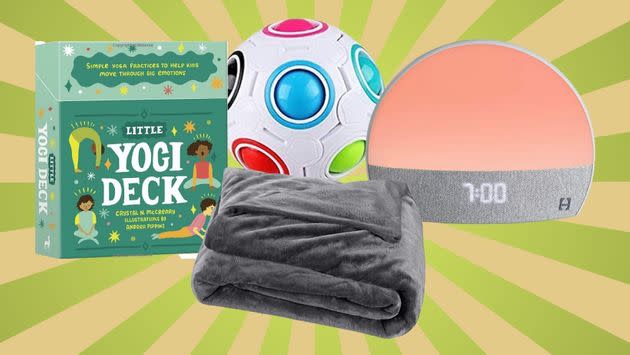The Best Toys, Tools And Gifts For Kids With Sensory Processing Disorders

It can be difficult to describe the overwhelming feeling brought on by sensory processing disorders. Bright lights feel irritating, large crowds become suffocating, and too many smells or sounds turn oppressive. Sensations that might seem completely run-of-the mill for a neurotypical person can be transformed into challenging hurdles for individuals who have difficulties filtering the world around them.
Varleisha Gibbs, an occupational therapist and the vice president of Practice Engagement and Capacity Building at The American Occupational Therapy Association, explained that SPDs can manifest in different ways ― it’s more than just meltdowns or tantrums.
“We all take in a multitude of sensations at any given moment. Some are challenged with the ability to interpret, organize or respond to such sensory information in a way that allows them to effectively engage with others and participate in everyday life activities,” Gibbs said. “They may present with difficulty ‘modulating’ revealed in avoiding certain sensations, seeking out intense sensations and input to their body, or simply lack an appropriate response or fail to attend to stimuli.”
Like most neurological disorders, they can be varied from one person to the next and can involve more than just the five senses we automatically think of.
“Some kids are sensory-seeking and others may be sensory-avoidant,” said Amanda Morin, the director of Thought Leadership and Expertise at Understood, an organization that seeks to enrich the lives of individuals with learning differences.
She also pointed out that many kids’ body awareness and spacial orientation are impacted. “These can affect kids’ ability to know where their body is in relation to others or objects or to pay attention to their body’s signals,” Morin said.
As a parent, caregiver or loved one, you may wonder what tools you can use to potentially help a child process their senses in ways that are comfortable, developmental and empathetic.
“If the toy is interesting enough to a child so they are engaged with toy instead of feeling overwhelmed by what is going on around, then these types of toys can be a good tool for redirection and distraction,” said Anson Koshy, a board-certified developmental and behavioral pediatrician in Houston.
Rondalyn Whitney, a clinical researcher, occupational therapist and associate professor of occupational therapy at Clarkson University, stressed that each child is different and that you need to look for more than a one-size-fits all “trendy” toy that has been marketed as a sensory processor.
“In order for a ‘toy’ to help, it has to provide a way to balance the sensory system,” she said.
Whitney said how you introduce sensory play is more important than the kind of toy you use.
“The key in sensory-based play is that it is child-directed,” she said. “The more sensory-based play opportunities, self-directed, we provide, the better we support the development of the sensory-motor system. Integrating sensory play into a family’s routines is the best advice, for instance smelling vanilla before baking cookies.”
Morin also underscored this when discussing the concept of a “sensory diet,” which encompasses various activities to engage a child’s senses.
She advised considering two main factors when shopping for sensory processing toys: “Is the toy just adding to the sensory information a child has to filter through, and does what the toy proposes to do match the sensory needs of the child?”
For instance, you wouldn’t get a vacuum cleaner toy for a child who doesn’t like loud noises, but you might consider it for a child who is drawn to vibrational sensations.
This is where observation comes in.
“We need to improve the understanding of development, how to observe children at play and how to provide interesting and interactive play that supports their persistence and enjoyment. The more we persist with a challenge, the more those neurons grow,” Whitney said.
Whitney left us with a salient reminder: “The message, in my mind, is to view each child as unique and find what brings him or her joy.”
With the help of these knowledgeable experts, HuffPost compiled a list of gifts for your sensory sensitive child that, at the very least, might “bring them joy.”
HuffPost may receive a share from purchases made via links on this page. Every item is independently selected by the HuffPost Shopping team. Prices and availability are subject to change.
This article originally appeared on HuffPost and has been updated.

 Yahoo Sports
Yahoo Sports 

